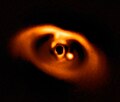| Star designation | Stellar
class | Magnitude | Right ascension
(J2000) | Declination
(J2000) | Distance
(light-years) | Reason for dimming |
|---|
| Apparent | Absolute |
|---|
| ASASSN-V J193622.23+115244.1 | — | 14.0–15.5 [1] | — | 19h 36m 22.23s [1] | +11° 52′ 44.1″ [1] | 6592 [1] | Unknown |
| ASASSN-V J213939.3-702817.4 | F0V [2] | 12.95–14.22 [3] | 2.5 [3] | 21h 39m 39.3s [3] | −70° 28′ 17.4″ [3] | 3630 [2] | Unknown |
| Betelgeuse | M1-2 [4] | +0.50 [5] | — | 05h 55m 10.30536s [6] | +07° 24′ 25.4304″ [6] | — | "large-grain circumstellar dust" [7] [8] |
| EPIC 204278916 | M1 [9] | 13.7 [10] | — | 16h 02m 07.576s [11] | −22° 57′ 46.89″ [11] | — | Dust disk |
| ASASSN-24fw [12] | | 14 | 17 | 17h 05m 18.98s [13] | 06° 12′ 19.5″ [13] | 3290±60 | Circumplanetary disk around an orbiting planet |
| EPIC 204376071 | M [14] | — | — | 16h 04m 10.1267s [15] | −22° 34′ 45.5503″ [15] | 440 [14] | Possibly giant planet or brown dwarf with rings |
HD 139139
(EPIC 249706694) | G3/5V | 9.84; [16] 9.677 [17] | — | 15h 37m 06.215s [17] | −19° 08′ 32.96″ [17] | 350 [18]
572 [17] | Unknown. Observed dimmings may have been due to instrumental errors. |
| KH 15D | K7 [19] | 15.5–21.5 [20] | 6.226 [21] | 06h 41m 10.31s [22] | +09° 28′ 33.2″ [22] | 773 [23] | Possibly circumbinary disk |
KIC 4150611
(HD 181469) | Pulsator/K/M/G | — | — | 19h 18m 58.21759s [24] | +39° 16′ 01.7913″ [24] | — | Five-star system |
| PDS 110 | keF6 IVeb [25] | 10.422 [25] | 2.54 [25] | 05h 23m 31.008s [25] | –01° 04′ 23.68″ [25] | 1090 [25] | Possibly eclipses by circumstellar dust [26] |
| RW Cephei | K2 0-Ia [27] | 6.0–7.6 [28] | — | 22h 23m 07.01521s [29] | +55° 57′ 47.6244″ [29] | 11,000 [30] [a] | Great dimming event similar to Betelgeuse |
| RZ Piscium | K0 IV [31] | 11.29–13.82 [31] | — | 01h 09m 42.056s [32] | +27° 57′ 1.95″ [32] | 550 [33] | Substantial mass of gas and dust, possibly from disrupted planet |
Tabby's Star
(KIC 8462852) | F3V [34] [35] | 11.705 [35] | 3.08 [34] | 20h 06m 15.4527s [34] | +44° 27′ 24.791″ [34] | 1470 [34] | Unknown |
| TIC 400799224 | — | — | — | — | — | — | "probably from an orbiting body that periodically emits clouds of dust that occult the star" [36] [37] |
| V1400 Centauri | K5 IV(e) Li [38] | 12.31 [38] | — | 14h 07m 47.93s [38] | −39° 45′ 42.7″ [38] | 434 [39] | Eclipse by a free-floating brown dwarf or rogue planet with a circumstellar disk or ring system [40] |
| VVV-WIT-07 | — | 14.35–16.164 [41] | — | 17h 26m 29.387s [41] | −35° 40′ 6.20″ [41] | 23000/? [41] | Unknown |
WD 1145+017
(EPIC 201563164) | DB [42] | 17.0 [43] | — | 11h 48m 33.63s [42] | +01° 28′ 59.4″ [42] | 570 [44] | Dust disk |
ZTF J0139+5245
(ZTF J013906.17+524536.89) | DA [45] | 18.4 [45] | — | 01h 39m 06.17s | +52° 45′ 36.89″ | 564 [45] | Dust disk |
| Gaia17bpp | M0-III | 16.13–20.48 [46] | — | 19h 37m 23.16s | +17° 59′ 02.90″ | 27,600 [47] | Dust disk |
| Gaia21bcv | K4.5V | 17.70–20.12 | 3.2 | 07h 14m 33.276s | −12° 13′ 27.34″ | 4,508 | Eclipse by a substellar companion with a 0.5 AU-radius debris disk [48] |
| ASASSN-21js | B [b] | 12.8 | 1.38 | 11h 47m 11.754s | −62° 10′ 36.80″ | 9,149 | Eclipse by a distant substellar companion with a 1.05 AU-radius debris disk [49] |
| WD 1054–226 | DAZ | 16.0 | — | 10h 56m 38.63s | −22° 52′ 56.08″ | 118 | Debris disc [50] |


